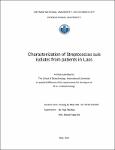| dc.description.abstract | Introduction
Streptococcus suis infection is a severe zoonotic pathogen commonly found in the Asian countries. Here we report for the first time the research data on S. suis strains isolated from infected humans in Laos.
Methods
In this study, 10 isolates from Laotian patients were characterized to understand their potential virulence as well as antimicrobial resistance profiles. Their genetic relationship was investigated using pulse field gel electrophoresis (PFGE) and multilocus sequence typing (MLST) techniques.
Results
Based on specific PCR confirmation, 8 out of 10 strains were identified as S. suis serotype 2, and the other two ones belonged to other species. We found the presence of the extracellular protein factor (epf) and suilysin (sly) as well as 3 newly hypothesized virulence genes ssnA, sspA and opacity – factor for S. suis (ofs) in all strains while muramidase protein (mrp), factor H- binding protein (hp0272) and the surface protective antigen (hp0197) were presented in 4 isolates. The two – component regulatory system (salK/R) was only possessed in only two Laotian strains. In addition, all 8 S. suis serotype 2 strains showed susceptibility to penicillins (penicillin, amoxicillin, ampicillin), carbapenems
2
(imipenem), cephems (ceftriazone, cefepime), ansamycin (rifampin), glycopeptides (vancomycin), fluoroquinolone (oflaxacin, levofloxacin), enrofloxacin and chloramphenicol. But 100% of these strains showed resistance to amikacin and tetracycline. Resistance to lincomycin, clindamycin and azithromycin was found in 87.5% isolates, while 75% investigated strains resisted to erythromycin including intermediate resistance. Besides, tobramycin resistance was revealed in 4 of 8 strains. Furthermore, all of investigated strains contained tet genes in their genomes while amplicons of genes erm(A) as well as erm(B) were not found in erythromycine resistant strains. Based on the dendogram in PFGE, 8 Laotian strains showed 4 different patterns, in which 4 strains were grouped with strains isolated from patients in Vietnam and Cambodia while the other 4 ones were clustered with strains from pigs isolated in Vietnam in 2012 to 2013. In the MLST, 8 investigated strains represented two sequence typings (ST), ST1 and ST104.
Conclusion We report here that S. suis is human pathogen in Laos. Our study show that Laotian strains were greatly diverse and contain at least 5 virulence factors in their genome. Five out of six S. suis strains investigated in this study are resistant to at least three tested antimicrobial agents.
Key words: Streptococcus suis, virulence factors, antimicrobial resistance, PFGE, MLST | en_US |


